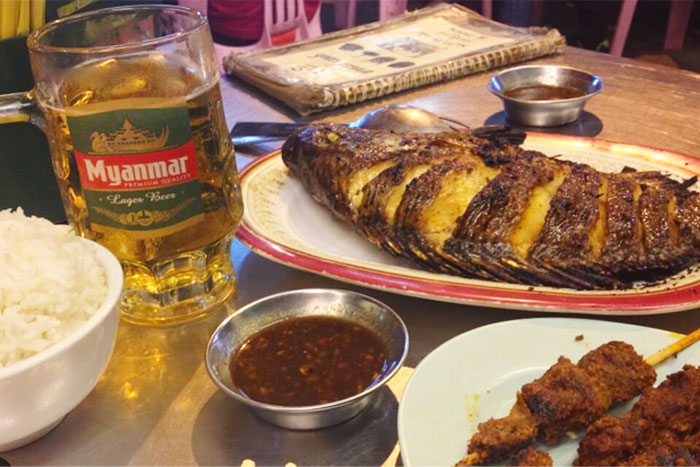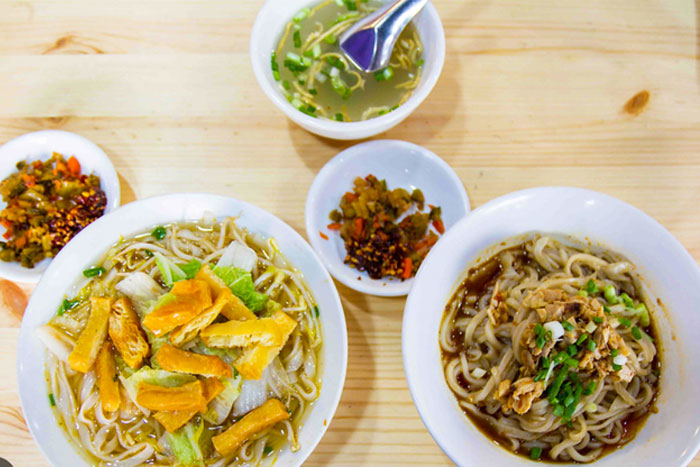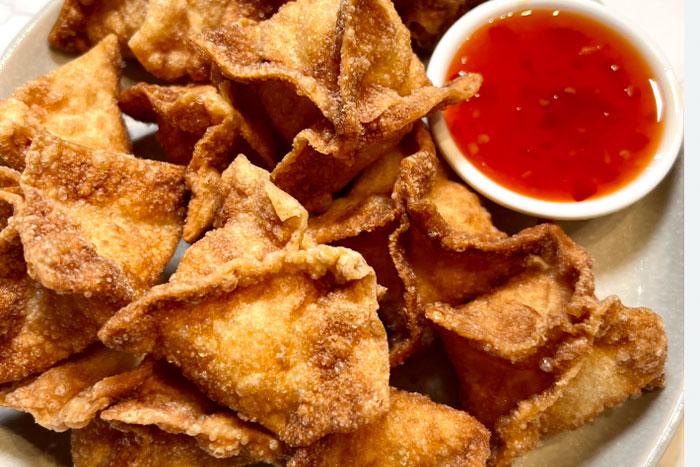
Yangon street food is an elite culture, which has been admired and praised by many foreign tourists. When coming to this beautiful city, you definitely have to look for the most famous and popular street foods here. I will suggest to you extremely delicious and impressive dishes in Yangon based on my actual experiences through my review about Yangon street food. Let's explore now!
Myanmar is a country with countless unique and attractive things. Having had the opportunity to travel to this country in 2017, I was impressed by its captivating landscapes, delectable cuisine, and warm-hearted people. Recently, The idea of a long weekend in Yangon was born from the reopening of Myanmar's tourism sector. A friend and I seized the opportunity to embark on a journey facilitated by a reputable travel company.
The destination we chose this time was Yangon, a city famous for its vibrant markets and countless colorful traditional street foods. Exploring Yangon's street food is a great initiation to the city's diverse cuisine. Led by a tour guide who gives insightful explanations about local cuisine in Yangon, we enjoyed an exciting culinary journey that included sampling dishes from various roadside stalls to cuisine in a family-owned restaurant.
Our primary aim for this trip was to immerse ourselves in the local culinary delights, and I must say that Yangon street food surpassed all expectations. With the desire to share this interesting experience with everyone, I have compiled a review about Yangon street food based on my actual experiences to provide you with insights. Know more deeply what you can consider for your upcoming trip.
I. Chinatown
We visited Sule Pagoda in the afternoon, took photos and visited the temple. Waiting until evening, we watched the sunset at the temple. At a quiet time with ideal lighting conditions, we took perfect photos. After taking pictures, I was hungry. We moved to nearby Chinatown.
Chinatown is Yangon street food night market. As the name suggests, it's a center of activity primarily influenced by Chinese culture. The bustling Chinatown night market surprised us with its bustling atmosphere and countless colorful stalls. All created an irresistibly charming scene. This night market exploration was an interesting experience that provided us a culinary journey with not only famous Chinese dishes but also the interesting cuisine of Myanmar.
1. Barbecue and local beers
Chinatown emerges as the go-to destination for everyone who is seeking the best food in Yangon. I could see an array of delectable Chinese delights such as various noodle dishes, steamed pork sticks, sticky rice with pork or chicken, barbecue treats, and an assortment of traditional Chinese and Myanmar snacks. Beyond the diverse culinary offerings, this vibrant locale served as an atmospheric venue where we could savor inexpensive local beers and cocktails while immersing ourselves in the lively ambiance of Yangon's nightscape. This bustling hub attracts crowds day and night, a testament to its popularity. Our choice for the Shwe Mingalar restaurant on 19th street was a choice based on the appealing freshness of their displayed food trays. Our culinary journey at this locale included indulging in delightful barbecue squid and other mouthwatering morsels, complemented by refreshing cold beers, both bottled and on draft. Seated on the street's edge, we relished the spectacle of the lively street life—a truly worthwhile night out.
Despite initial concerns about hygiene, we dined at Shwe Mingalar without any ill effects. The barbecue fish, in particular, stood out—fresh, flavorful, perfectly spiced, and expertly cooked. While the dishes tended to be on the milder side, spice enthusiasts could request an extra kick with some added chili. The overall cost for a satisfying meal for two, accompanied by beers and soft drinks, amounted to approximately 20$ —an excellent value compared to Yangon food’s prices, which would easily be double the amount for a comparable experience.
2. Shan noodles
Indulging in Shan Khao Swe, or Shan Noodles, is a culinary adventure that beckons exploration. Our tour guide introduced to us that this Burmese street food in Yangon was a specialty of the Shan people, residing in both Myanmar and Thailand. This is what brings the uniqueness of the noodle dish and a special experience for those who enjoy it. For those acquainted with Thai cuisine, some similarities may be discerned, but the nuances are unmistakable. Shan noodles are chewier and more flavorful, providing an interesting difference from familiar dishes. Served in various forms, the dish can be relished either as a noodle soup, dry with broth on the side, or infused with a choice of sweet or spicy oil—though the noodle soup variation tends to be the most popular. Notably, I think the Shan-style noodle broth distinguishes itself with a richer, oilier, and more savory profile compared to its Thai counterparts.
We enjoyed Shan noodles with a broth made from chicken instead of pork, giving it a delicate and delicious flavor. The broth, simmered with an assortment of mixed spices, tomatoes, mustard greens, and meat, often includes a garnish of cooked pork rinds. These noodles comprised delicate rice strands, elegantly adorned with a sprinkling of finely crushed peanuts atop. To elevate the flavors further, I opted to enhance the dish with a touch of smoky chili oil, readily available as a tabletop condiment. Remarkably, the price point of 1 to 2.50 USD per bowl of these delectable Shan Noodles added to their allure, making them a delicious dish in my review about Yangon street food! The Shan noodles are delicious. It may be spicy if you want some chilies.
3. Tea-leaf salad
Myanmar's cuisine is renowned for its unique dishes, the highlight of which is tea-leaf salad. Roaming Yangon street food night market, we discovered numerous carts in the evening, each adorned with a tempting display of Laphet thoke – a delightful concoction featuring fried shallots, peanuts, lettuce, toasted split yellow beans, deep-fried beans, plucked corn, chopped tomatoes, fried anchovy fish, and a hint of chilies. All these elements harmonize with the flavorful essence of fermented tea leaves, creating a unique warmth that resonates with those indulging after a day's work or sharing the experience with family and friends. Tea-leaf salad is a common appetizer at banquets and a frequent companion to white rice during Burmese dinners.
Despite my usual preference for cooked tomatoes, I found myself intrigued by the raw tomato salad. Comprising thinly sliced tomatoes and shallots, some chilies, fried garlic, peanuts, sesame seeds, and a splash of lime, this delicious dish presented a surprising and delightful departure from my culinary expectations. Locals described the salad as having a sour and spicy profile, though to my palate, the taste was remarkably mild.

II. Strand Night Market
We walked along the Strand Road when visiting Boatataung Pagoda. There were many old buildings with lots of interest and beautiful architectural and decorative details, so it's worth slowing down in the heat of the day to take it slow to notice them. So we decided that after visiting the temple, we would return here to explore more closely as well as visit the Strand Night Market.
When we returned, it was in the afternoon. Our guide took us on a tour to show the British colonial heritage. It covered many historic buildings like -- City Hall, Old Post Office, Strand Hotel, .... Many buildings had been converted to other uses, but retained the grandeur. After visiting, it was already dark. Strand Road is a part of Chinatown, it takes a short walk to enjoy local dishes here. Therefore, many people can miss this culinary paradise. Foreigners do not often visit this area, so prices are very reasonable and most shops do not have English menus. Luckily, we had a tour guide with us and he provided a lot of information for me to write this review about Yangon street food. We felt that it was so great to be visited at night to have a taste of their local street food. Strand Road is transformed from a busy street to a stretch of street food at night.
1. A Kyaw Sone
I thought "A Kyaw Sone" was a culinary pleasure of Yangon Street Food. A Kyaw Sone includes many eye-catching deep-fried items such as onions, potatoes, peas, bananas, shrimp, and so on. Most of these delectable fried offerings are crafted from a blend of sticky rice flour, rice flour, or a harmonious combination of both. This foundation is intricately mixed with finely chopped onions, garlic, and ginger, infusing the dish with a rich and enticing aroma when introduced to the sizzling oil pan. To augment the diversity and appeal of these fried treats, the flour mixture is further enriched with a medley of additional ingredients. In addition to its delicious taste, the tour guide also introduced us to the fact that this dish is specially prepared with unrefined oil. Notably, it remains an affordable culinary option. To enhance the experience, my advice is eating "A Kyaw Sone" with warm water.
The true magic of "A Kyaw Sone" lies in its sauce—an element that requires a special touch. We felt that the sauce was the soul of this dish. Our tour guide said that not everyone can create the perfect sauce, this will be an important deciding factor for visitors to choose to enjoy this Yangon food. The choice of the right sauce is an integral part of the "A Kyaw Sone" experience for the discerning Myanmar palate. For many in Myanmar, sharing a plate of "A Kyaw Sone" with friends, coupled with a pot of plain tea, is considered one of life's simple pleasures. This delightful combination of a pleasant evening gave us the perfect moment to enjoy this flavor.

2. Mont Lin Ma Yar
Mont Lin Ma Yar stands out as a beloved and flavorful dish which I cannot help but mention in this review about Yangon street food. I saw this dish was very popular with locals. This delectable treat earns its name due to its distinctive circular shape, comprising two interconnected parts. While there isn't a fixed recipe for this Myanmar snack, the skilled stall operators expertly portion the mixture to form the characteristic "couple." Upon my first glance, Mont Lin Ma Yar bore a resemblance to the takoyaki dumplings of Japan. The visual parallels may lead one to ponder a shared origin between Japanese takoyaki and Myanmar's Mont Lin Ma Yar. However, in my opinion, a key distinction sets them apart: the absence of octopus in the Myanmar version, as implied by its name.
Crafted using rice flour, spring onions, and baking soda, these miniature dome-shaped pancakes boast a unique texture—crisp around the edges yet delightfully soft on the inside. The option to include a quail egg adds another layer of flavor, but personally, I found the vegetarian version, without egg, to be particularly appealing. This famous food in Yangon is a culinary delight when fried to a bubbly, golden crisp on the outside while maintaining a delicate interior. Best enjoyed piping hot, straight off the pan, these sinfully delectable treats were so irresistible that keeping track of the number consumed became a delightful challenge in my life.
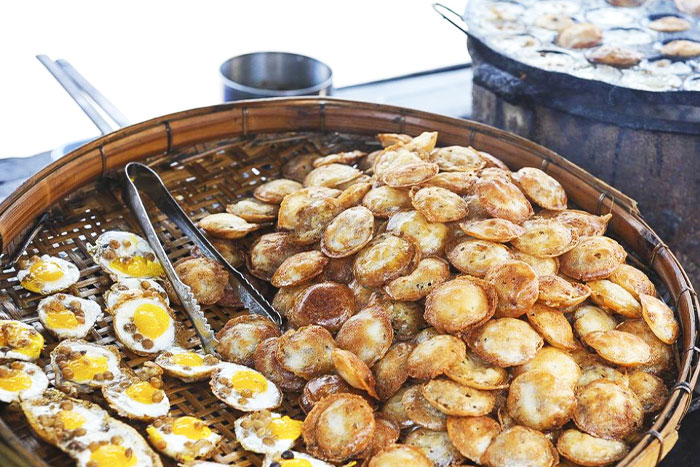
3. Crab Rangoon
Crab Rangoon, in my opinion, is considered more of an appetizer than a standalone dish. The stuffing comprises cream cheese and small bits of imitation crab, all enclosed within a crispy wonton wrapper and expertly deep-fried. We were served alongside a syrupy, neon-hued sweet-and-sour dipping sauce. Our guide introduced that crab Rangoon's signature flavor was derived from the use of surimi, and cream cheese encased in the delicate wonton wrapper. Surimi is made from pollack, a deep-sea fish that mimics the taste and texture of crab, and undergoes additional processing for shaping and coloring. I thought that the addition of diced scallions to the filling could provide a delightful twist, enhancing the overall experience of Burmese street food in Yangon.
While our initial hesitations arose from concerns about not being avid fans of crab, the harmonious blend of cream cheese and chili sauce proved to be an unexpectedly delicious combination. However, a minor caveat emerged as these delectable bites left a slight desire for more substantial satiation, given their modest filling. Remarkably, the flavor profile undergoes a transformation when consumed without sauce, revealing a pronounced fishiness. Yet, judiciously using ample chili sauce cleverly relegates this fishy undertone to the background. It allows the other flavors to take center stage and creating a more palatable culinary experience in my review about Yangon street food.
III. Maha Bandula Park
Nestled adjacent to the iconic Sule Pagoda-one of
interesting places to visit in Myanmar at the heart of Yangon, Maha Bandula Park serves as a serene oasis amid the bustling cityscape. In the midst of the lively urban activity of Yangon, the park attracted numerous individuals indulging in picnics or leisurely strolls through its verdant expanse. Embarking on our culinary adventure, we departed from our hotel at the early hour of 6 am, a strategic move to outpace the morning rush. Our guide led us to the street food market near Maha Bandula Park.
Here, a captivating scene unfolded before us, as an assortment of bowls, soups, noodles, and various accompaniments were meticulously arranged on a counter. Maha Bandula Park has diverse street food stalls. The stalls made us feel the vibrant atmosphere. It offers Yangon food at affordable prices. This park has not only become a place to relax, but also a culinary paradise.I could say that this is where locals and tourists alike can enjoy the flavors of Yangon in a comfortable outdoor setting in this review about Yangon street food.
1. Mohinga
My first experience of culinary delight that morning was Mohinga. It is composed of rice noodles or vermicelli immersed in a curry gravy sauce infused with a fish base. The ingredients of this dish include ginger, garlic, onions, lemongrass and a series of dry spices. Traditionally associated with Myanmar's breakfast scene, Mohinga is now readily available throughout the day, particularly in the vibrant market. Taking my place at one of the petite plastic tables scattered amidst the backdrop of Yangon City Hall's parking lot, I surveyed Sule Pagoda in the distance. We ordered three generously portioned bowls of steaming mohinga soon graced our table, accompanied by an assortment of additions—chili flakes, lime wedges, fish sauce—inviting a personalized touch to our culinary adventure.
As gourd fritters contributed a crispy texture to the soup, the street food atmosphere enveloped us in its charm, epitomizing the essence of travel and culinary exploration. The noodles seamlessly intertwined with the broth, resembling more of a curry gravy sauce. The broth revealed delightful undertones of lemongrass, onions, and generous chunks of mild ginger. This culinary escapade epitomized the sheer joy of travel and the delightful surprises encountered in every Burmese street food in Yangon.

2. Wat Thar Dote Htoe
A visually pleasing arrangement unfolded as skewers of sliced meats were meticulously displayed in a fan shape around the edge of the pan. This dish comprises a pile of innards and gizzards, featuring fat tongues and sponge-like tripe. The diverse array of ingredients encompassed internal organs such as liver, intestines, kidneys, spleen, heart, lungs, tongue, as well as meat, skin, and cartilage—various components that constitute the entirety of the pig. This Burmese street food in Yangon's allure lies in its affordability and substantial, filling nature. One such local specialty, Wat Thar Dote Htoe (pork sticks), epitomizes the simplicity of on-the-go food, unique to Myanmar and widely embraced.
Inquisitive, I gestured toward the cooking stall, seeking insights from my guide about the culinary process. The procedure unfolded effortlessly: skewers with pre-cooked meat slices were briefly warmed in the savory gravy before being dipped into a slightly sweet and sour sauce presented in a bowl before us—an uncomplicated yet enticing preparation. I sampled three distinct pieces—a slice primarily composed of fat, a section of lip, and a sliver of large intestine. The first two proved flavorful, enriched by the essence of pan-roasted pork and the complementary dipping sauce. The large intestine, while slightly chewy, retained a delectable quality, making for a satisfying culinary exploration. The simple and authentic allure of Yangon street food unfolded, showcasing the unique charm of local gastronomic delights.
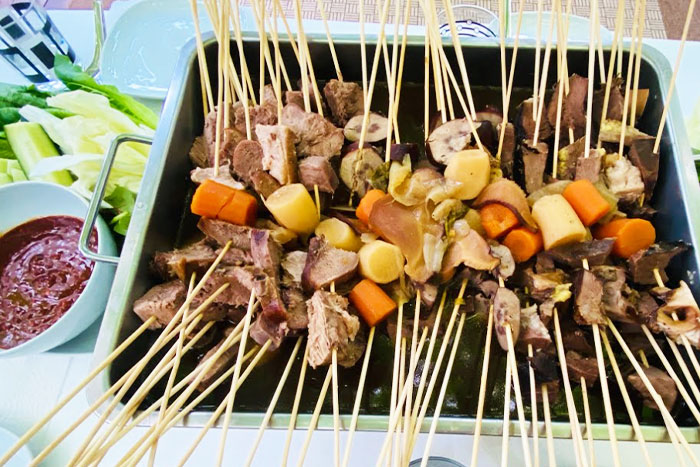
Embarking on a journey to explore the enchanting realm of Buddha-land becomes even more captivating with a visit to the renowned Yangon street food night market. In addition to the special appeal of Myanmar's architecture and rich culture, the vibrant night markets are also attractive attractions, attracting many tourists, including me. Immerse yourself in the bustling energy of these captivating night markets, offering an exciting tour that promises unique experiences and memories to cherish. You can gather your friends and embark on a short but enchanting trip to explore the wonders of these vibrant night markets, adding excitement to your Myanmar adventure.
This is all of my review about Yangon street food. My trip went very well and I wish you the same.
England, 12 December 2022
Bruce Watt


